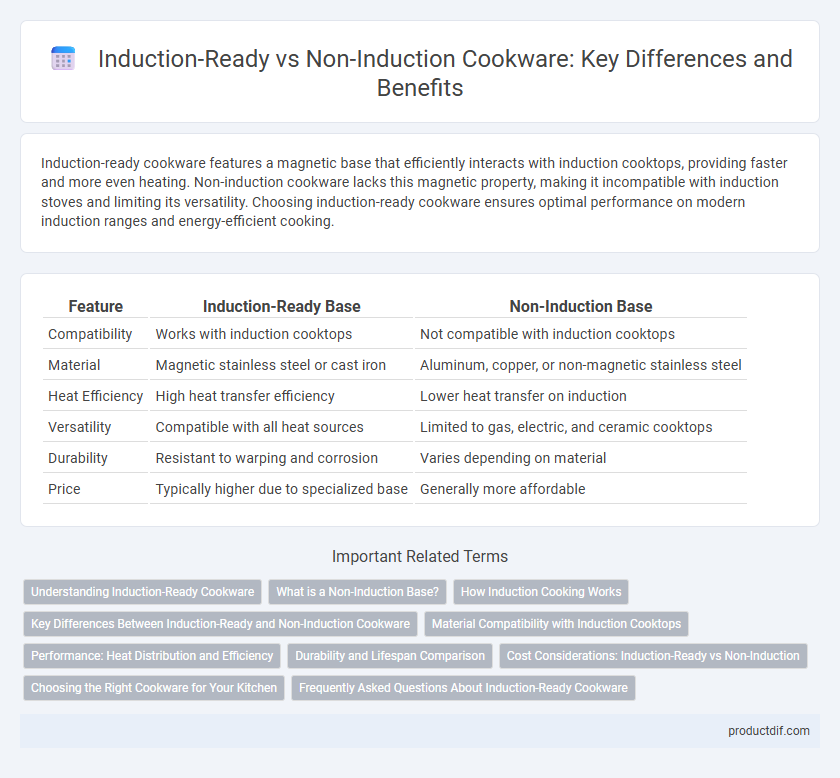Induction-ready cookware features a magnetic base that efficiently interacts with induction cooktops, providing faster and more even heating. Non-induction cookware lacks this magnetic property, making it incompatible with induction stoves and limiting its versatility. Choosing induction-ready cookware ensures optimal performance on modern induction ranges and energy-efficient cooking.
Table of Comparison
| Feature | Induction-Ready Base | Non-Induction Base |
|---|---|---|
| Compatibility | Works with induction cooktops | Not compatible with induction cooktops |
| Material | Magnetic stainless steel or cast iron | Aluminum, copper, or non-magnetic stainless steel |
| Heat Efficiency | High heat transfer efficiency | Lower heat transfer on induction |
| Versatility | Compatible with all heat sources | Limited to gas, electric, and ceramic cooktops |
| Durability | Resistant to warping and corrosion | Varies depending on material |
| Price | Typically higher due to specialized base | Generally more affordable |
Understanding Induction-Ready Cookware
Induction-ready cookware features a magnetic base made from ferrous metals such as stainless steel or cast iron, enabling efficient heat transfer on induction cooktops. Non-induction cookware lacks this magnetic property, making it incompatible with induction cooking surfaces. Selecting induction-ready cookware ensures rapid, even heating and energy efficiency when used with induction stoves.
What is a Non-Induction Base?
A non-induction base refers to cookware designed without magnetic properties, making it incompatible with induction cooktops that rely on electromagnetic energy for heating. Typically made from materials like aluminum or copper without a ferromagnetic layer, non-induction cookware works well on gas, electric, and ceramic stoves but cannot generate heat on induction burners. Understanding the difference in base composition helps ensure cookware selection matches the cooking surface for optimal performance and efficiency.
How Induction Cooking Works
Induction cooking relies on electromagnetic fields created by an induction-ready base, which must contain ferromagnetic materials like stainless steel or cast iron to generate heat directly within the cookware. Non-induction bases, typically made from aluminum or copper without a magnetic layer, cannot produce the necessary magnetic reaction, rendering them incompatible with induction cooktops. The efficiency of induction cooking stems from this direct heat transfer, offering rapid temperature changes and precise control compared to traditional gas or electric stoves.
Key Differences Between Induction-Ready and Non-Induction Cookware
Induction-ready cookware features a magnetic base, typically made of ferrous metals like stainless steel or cast iron, enabling efficient heat transfer on induction cooktops, whereas non-induction cookware lacks this magnetic compatibility and cannot generate heat on such surfaces. The flatness and material composition of the base significantly impact cooking performance, with induction-ready bases offering rapid, even heating and energy efficiency. Non-induction cookware often relies on traditional gas or electric stoves, resulting in slower heat response and uneven temperature distribution during cooking.
Material Compatibility with Induction Cooktops
Induction-ready cookware features a magnetic base typically made of stainless steel or cast iron, ensuring optimal compatibility with induction cooktops by creating the necessary electromagnetic field for heating. Non-induction cookware, often crafted from aluminum, copper, or glass, lacks the magnetic properties required and therefore will not heat properly on induction surfaces. Choosing cookware with a ferromagnetic base is essential for energy-efficient and responsive cooking on induction technology.
Performance: Heat Distribution and Efficiency
Induction-ready cookware features a magnetic stainless steel or ferrous base that ensures rapid and even heat distribution directly to the cooking surface, enhancing energy efficiency by minimizing heat loss. Non-induction cookware, often made from aluminum or copper without a magnetic layer, provides less consistent heating and wastes more energy due to less effective heat transfer on induction cooktops. The performance difference significantly impacts cooking precision and energy consumption, making induction-ready bases superior for induction stovetops.
Durability and Lifespan Comparison
Induction-ready cookware features a magnetic stainless steel or ferromagnetic base that ensures efficient heat transfer and superior durability compared to non-induction bases, which often rely on aluminum or copper without magnetic properties. The robust construction of induction bases resists warping and corrosion, significantly extending the cookware's lifespan under high heat and frequent use. Non-induction cookware typically exhibits faster wear and diminished heat retention, reducing overall durability and performance over time.
Cost Considerations: Induction-Ready vs Non-Induction
Induction-ready cookware typically carries a higher price tag due to the specialized magnetic base required for compatibility with induction cooktops, which ensures efficient heat transfer and energy savings. Non-induction cookware often costs less upfront but may lead to higher energy consumption and uneven heating on induction stoves, potentially affecting cooking performance and efficiency. Investing in induction-ready cookware can result in long-term savings through improved durability and reduced energy bills despite the higher initial cost.
Choosing the Right Cookware for Your Kitchen
Induction-ready cookware features a magnetic base compatible with induction cooktops, ensuring efficient and even heat distribution. Non-induction cookware, often made from materials like aluminum or copper, lacks this magnetic property and cannot be used on induction stoves. Selecting cookware with an induction-ready base guarantees versatility and energy efficiency, ideal for modern kitchens equipped with induction technology.
Frequently Asked Questions About Induction-Ready Cookware
Induction-ready cookware features a magnetic base compatible with induction cooktops, ensuring efficient and rapid heat transfer compared to non-induction cookware that lacks this capability. Common questions include how to test for induction compatibility using a magnet, which materials are induction-friendly--such as stainless steel and cast iron--and whether non-induction cookware can be adapted with induction interface disks. Understanding these key aspects helps consumers select cookware that maximizes performance on induction stoves while avoiding compatibility issues.
Induction-Ready Base vs Non-Induction Infographic

 productdif.com
productdif.com